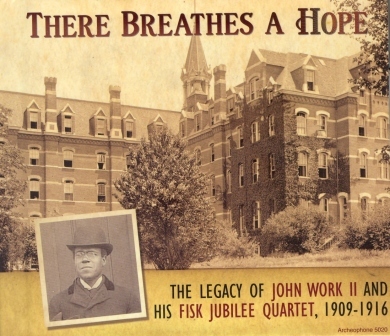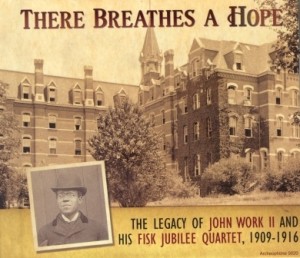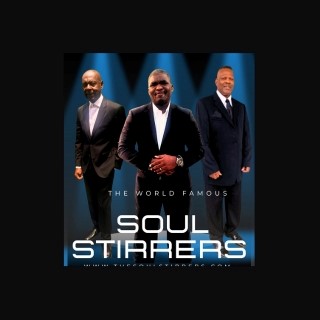The Legacy of John Work II and His Fisk Jubilee Quartet, 1909-1916
In the December 24, 2010 issue of the Wall Street Journal, reviewer Terry Teachout proclaimed There Breathes a Hope to be “the most important historical reissue of 2010.”
I couldn’t agree more.
There Breathes a Hope combines jubilee singing, rare photography, expert commentary and album design to produce what is more than a compilation: the two-CD set is a history lesson for the ages.
The package from Grammy-winning Archeophone Records opens with the Fisk University Jubilee Quartette’s historic first sessions for the Victor Record Company in 1909 and 1911. It concludes with the 1915-16 Columbia recordings and one of two known discs produced for the Richmond, Indiana-based Starr label in 1916.
While all of the recordings are superb, the real treats are smack-dab in the middle: nine cylinders from the quartet’s December 1911 session for the Edison Phonograph Company. These rare Edison four-minute cylinders have not been reissued until now. Seven were discovered in pristine condition by Ken Flaherty, Jr., a collector and the album’s co-producer, at a flea market ten years ago.
Unlike the Victor and Columbia recordings, the Edison cylinders capture the vibrant quartet when it was graced with the soon-to-be concert singer Roland Hayes as second tenor. Listening to the crystal-clear high notes of Hayes and John Work II on selections such as “All Over This World” and “My Soul is a Witness” is magical. The superior audio quality of Edison product bestows a brightness to the performances that pre-electric Victor and Columbia could not capture, although Columbia came closest. In any event, the chance to hear these nine cylinders are alone worth the purchase price.
Equally inspiring is hearing the quartet perform beyond the three-minute limitation of the ten-inch phonograph record. For example, “Swing Low Sweet Chariot” clocks in at 4:34. This is as close to hearing the quartet performing the arrangements in concert as we in the twenty-first century are likely to experience.
The famed Fisk Jubilee Singers were too large an ensemble to capture via acoustic recording horns, so four gentlemen were assembled as the Fisk University Jubilee Quartette to make recordings. Thanks to Work’s direction, the group was known for its tight a cappella harmonies, tenor leads, and vibrant rhythms on selections such “The Old Ark,” “Golden Slippers,” “Brethren, Rise Shine,” “Peter on the Sea,” and “I Know the Lord Laid His Hands on Me.” On “The Ole Ark,” from the Edison session, one of the members punctuates the energetic singing with quick wordless exhortations, anticipating the enthusiastic interjections common to gospel music.
Written by : Bob Marovich
Bob Marovich is a gospel music historian, author, and radio host. Founder of Journal of Gospel Music blog (formally The Black Gospel Blog) and producer of the Gospel Memories Radio Show.












 Visit Today : 2425
Visit Today : 2425 This Month : 47770
This Month : 47770